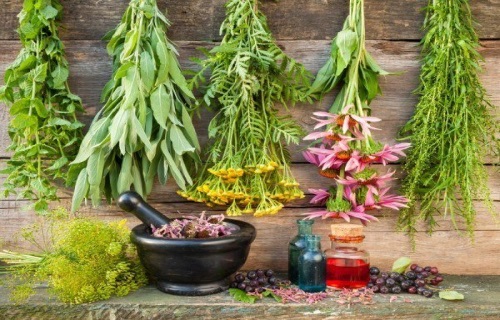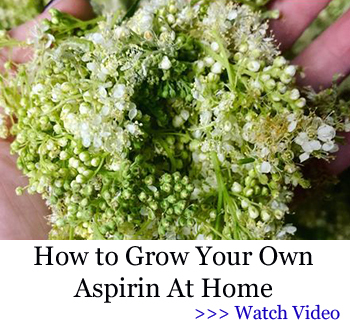In an ideal world, we would each have inherited the ability to conjure a personal list of essential garden herbs, tailored to our particular climate and health concerns. As it is, many of us are re-learning the traditional art of the apothecary garden—a place where beauty, medicine, and bees reign supreme.
My hope is that the information below inspires you, as a jumping board of sorts, to create your own unique dream herb garden. I chose each plant based on its ease of cultivation and medicinal usefulness and versatility. But bear in mind, there are many more herbs out there to choose from!
Thinking of starting a medicinal herb garden? Growing medicinal garden plants allows you to harvest homegrown remedies right outside your door. Here are more than 45 medicinal plants to consider growing in your garden this season.
While many of us grow medicinal plants without even realizing it, some folks grow gardens filled with medicinal herbs they use to stock homegrown apothecaries.
HOW TO CHOOSE PLANTS FOR YOUR MEDICINAL HERB GARDEN
With so many wonderful medicinal plants to choose from, how do you pick what to grow? I’d advise starting with plants you think you’ll actually use. So if you’re a fan of tulsi, chamomile, or lemon balm tea, those are good places to start.
Plants for the home medicinal garden :
Calendula – Gorgeous flowers excellent for many uses
Tulsi – Great for tea, fresh or dried
Chamomile – Great as a tea fresh or dried, wonderful nervine, aid upset stomach, calm upset children
Mint (in pots) – Helps some formulas work a bit better, tastes good in tea, great for drying, great for sun tea infusions
California Poppy – Best tinctured fresh and so easy to grow from seed. A family favorite for tea
Spilanthes – Fabulous antiviral, antibacterial, antimicrobial. Fun for kids to grow and taste. I use it a lot and it’s very easy to grow
Lemon Balm – Great taste and so relaxing. Best to tincture when fresh as opposed to dry, so grow it yourself to be able to do that
American Skullcap – Great nervine which, along with California poppy and lemon balm, is best when tinctured fresh
Sage – So useful for so many things: Hot flashes, seasoning food, make an herbal honey that works great as a cough syrup
Solomon’s Seal – Great for all things musculoskeletal as well as digestion
Yarrow (white) – Good for bruising, stopping bleeding, pain relief, one of my most used with grandkids
Lavender – Great for a lovely tea, massage lotion, add to baked goods, digestion. A favorite for many.
- Medicinal Garden
- With your seeds kit, you’ll also receive a FREE Medicinal Guide that shows you how to turn these 10 plants into tinctures, ointments, salves, poultices, decoctions, infusions, essential oils —all in minute detail so you can follow our guide even if you’ve never made an herbal medicine in your life.
It can be difficult to keep up with harvesting and processing all the medicinal herbs in the garden, so don’t go overboard when you’re first starting out or you’ll likely find it’s too much.
Note which medicinal plants are perennial in your growing zone, or are suited to conditions like part shade. Then also consider which might be especially useful remedies for you to have on hand, like plantain and violet (good herbs for cough, among many other uses).
Or perhaps you’d like to choose some herbs known for stress-relieving properties or herbs for sleep, including lemon balm, chamomile, valerian, and California poppy. Or plan to stock your apothecary with immune-boosting herbs like elderberry and echinacea.
USING MEDICINAL GARDEN HERBS SAFELY
Please note that when using medicinal herbs, you need to research their cautions and contraindications. Many herbs can affect the way prescription medications are absorbed by the body or are not recommended for certain health conditions. Look up this information and discuss any herbs you’re considering with your physician before consuming.
Little research has been done on the safety of medicinal plants during pregnancy, so proceed with caution and check with your doctor before using herbs in pregnancy.
WHERE TO GET PLANTS FOR THE MEDICINAL GARDEN
Many of these plants are perennial herbs, which means they can often be obtained as divisions from other gardeners, though you want to be sure the garden you’re getting it from isn’t one of the unlucky hosts of the dreaded jumping worm, an invasive you want to learn to recognize. Here’s what to know about identifying and dealing with Asian jumping worms.
If you want to avoid the possibility of contaminated soil, you can either grow these plants from seeds, or root them from cuttings. Here’s what to know about propagating plants from cuttings.
High Mowing Seeds, Botanical Interests, and True Leaf Market carry seeds for many of the medicinal herbs listed below. Seeds Now has a medicinal herb garden starter pack worth checking out.
The most expensive, but the quickest and easiest way to get your medicinal herbs, is as plant starts from a nursery. You’re less likely to find the more unusual medicinal plants at your local garden center, though, and you may need to purchase seeds for those.
WHAT TO GROW IN A MEDICINAL HERB GARDEN
Below you’ll find suggestions for some of the more common plants you might consider adding to your medicinal herb garden, as well as many useful wild plants that are often dismissed as weeds. Last, I’ll include a list of some of the less common plants you can add to your medicinal herb garden if you want to expand your homegrown herbal apothecary.
PERENNIAL HERBS TO GROW IN THE MEDICINAL GARDEN
Elderberry
Elderberry is on the shortlist for must-have herbs for the medicinal herb garden if you have the space. An elderberry plant will provide you with not one, but two medicinal (and delicious!) crops, elderberries and elderflowers. Here’s what to know about growing elderberry and elderberry varieties to consider for your growing conditions, including some compact cultivars for smaller-space gardens. If you live in a very cold or very warm climate, be sure to choose an elderberry suited to your growing zone.
Elderberry is best known for its immune-stimulating properties, but it’s also considered useful for arthritis and many other ailments, and as an all-around anti-inflammatory. Elderflower is often used for soothing skin and as a fever reducer, wonderful in elderflower tea or as a tincture.
Here are research-backed recipes for homemade elderberry syrup and elderberry tea. You’ll find loads more delicious recipes for elderflower and elderberry in my book, Everything Elderberry.
Lemon Balm
One of most herbalists’ favorite medicinal plants, lemon balm is delicious and a soothing de-stresser. Wonderful both fresh and dried in tea, lemon balm can also be tinctured.
A tough perennial, lemon balm is easy to grow from plant divisions or cuttings, so you can see if you can get plants free from another gardener. You can also grow it from seed.
Lemon balm can be a bit invasive in warmer climates, so harvest often if you don’t want it seeding the rest of your yard.
Here’s more on uses for lemon balm.
Peppermint
A go-to remedy for headaches and upset tummies, peppermint is also a delicious herb to keep on hand even if you don’t use it medicinally.
A notoriously aggressive plant, peppermint should grow somewhere you don’t mind it spreading. You can also grow it in a container to help keep it in check.
Lavender
The soothing scent of lavender has been studied for its beneficial impact on sleep quality. One especially lovely way to enjoy lavender is to grow your own and dry buds on the stem to keep in a vase by your bedside. They’re also delicious steeped with other sleep-promoting herbs in a relaxing bedtime tea.
Lavender needs full sun and well-draining soil. Lavender may have more concentrated essential oils when grown in poorer soils.
Thyme (Zones 2 to 10)
Besides being a delicious culinary herb, thyme has antimicrobial properties and is often recommended for treating coughs and respiratory infections.
Upright thyme is easier to harvest than creeping thyme, but creeping thyme spreads nicely as a groundcover, helping to reduce the need for mulch in garden beds. Thyme also makes a deliciously scented and beautiful grass alternative if you’re looking to replace some of your lawn.
Here are loads more ground cover herbs to consider. You can grow thyme beneath your taller plants as a living mulch. It’s often recommended as an elderberry companion plant.
Thyme is easy to propagate from divisions or cuttings, and once you have some, you can divide it to expand your thyme patch.
If you live in a cold climate, be sure to find a thyme suited to your growing zone, as not all can survive extremely cold winters.
Echinacea
Echinacea is well known as an herb for supporting immune function and fighting infection, and it’s a wonderfully drought-tolerant, pollinator-friendly plant to include in the medicinal herb garden.
Echinacea purpurea is considered easier to grow, and the whole plant may be used medicinally. Flowers, stems, leaves, and roots may be tinctured for use both internally and externally.
Echinacea prefers full sun but isn’t fussy about soil. A deep-rooted plant, it’s a good choice for areas that get less water.
Rosemary
Rich in antioxidants, rosemary is prized for its beneficial effects on pain and cognition. If your medicinal herb garden grows in zones 7 to 10, you may be able to grow this delicious herb all year round. If you live in a cooler climate, you can pot up your rosemary and grow it indoors, though it can be challenging to keep it happy in the winter.
Rosemary prefers full sun and high humidity and soil with good drainage.
Hyssop
Hyssop teas or syrup are often used to help with coughs, congestion, and fever. The leaves can be applied topically to alleviate pain and bruises.
Hyssop is yet another member of the mint family, but unlike many mints is not an aggressive spreader. Hyssop prefers full sun and makes a beautiful addition to the medicinal herb garden.
Note that anise hyssop (Agastache foeniculum) is a related, but different plant from hyssop (Hyssopus officinalis). Anise hyssop was used in similar ways by Native Americans.
Bee Balm / Bergamot
Bee balm’s other name, bergamot, comes from the plant’s delicious scent, which smells a lot like the fruit bergamot that gives Earl Grey tea its flavor. But these bergamots aren’t related, and many bee balm leaves taste a lot like oregano (not what you want in your tea).
Drying bee balm may improve its flavor for tea, and some people use the flower.
Bee balm has antimicrobial properties and is considered helpful for promoting digestion and alleviating bloating. An antispasmodic, it’s also used for menstrual cramps and coughs. Here’s more on using bee balm from The Herbal Academy.
Yet another member of the mint family, bergamot is also prone to spreading, making it a good candidate for sharing with others (or getting some from a neighbor). It’s relatively easy to pull, though.
Catnip
Most people don’t think of catnip as an herb for humans, but it’s useful for promoting sleep and a natural bug repellent. I put the catnip growing in my garden in my evening tea blend along with my fresh lemon balm, yarrow, and violets.
Catnip is an exceptionally hardy perennial, often one of the earliest herbs to green up in spring. Catnip self-sows readily, so cut the flowers before they seed if you don’t want it popping up in other parts of your yard.
A lot of people confuse catnip with catmint, a lovely garden plant that’s generally not used medicinally. Here’s what to know about catnip vs catmint.
Meadowsweet
High in salicylic acid (the active ingredient in aspirin), meadowsweet is anti-inflammatory, and a go-to for pain relief and digestive issues. In Backyard Medicine, Julie Bruton-Seal and Matthew Seal recommend a tea made with dried meadowsweet before meals for digestive issues or 1-3 cups daily for arthritis and rheumatic pains.
Meadowsweet prefers full sun but can tolerate some shade. A generally unfussy plant, meadowsweet doesn’t need a lot of special treatment and will thrive in average soils with consistent moisture. Meadowsweet clumps may be propagated by division every few years.
ANNUAL HERBS TO GROW IN THE MEDICINAL GARDEN
Chamomile
Chamomile is a go-to for tea that promotes relaxation and sleep. In the aster family, chamomile may bother those with ragweed allergies.
Chamomile’s tiny seeds may take up to three weeks to germinate, so plant them where you’ll remember to water them. Chamomile self-sows readily, so you may find volunteers in other parts of your garden..
German chamomile is generally preferred for herbal uses, though perennial Roman chamomile is also an option.
Tulsi
Tulsi, also known as holy basil, is considered an especially vaulable adaptogenic herb, which means it’s thought to help the body manage stress while providing numerous other benefits.
Tulsi is most commonly consumed as a tea, either on its own or combined with other herbs. Tulsi may can also be used as a spice on salads or cooked dishes.
You can grow tulsi as a perennial if you live in zone 10 or warmer, otherwise we grow tulsi as an annual. You can also bring tulsi indoors for winter.
Calendula
Calendula’s plentiful flowers make it a beautiful addition to the garden as well as a valuable ingredient in soothing homemade skincare.
Calendula flowers are also edible. You can add them to tea, or dry them and add the petals to wintertime cooking, where herbalists recommend them for symptoms of SAD. Here’s more on calendula from the Herbal Academy.
Calendula grows easily in poor soils and will self-seed if you don’t harvest all its plentiful flowers.
California Poppy
Beautiful California poppy is a go-to for those in need of more restful sleep. An antispasmodic and nervine, California poppy can help soothe tension and anxiety. Here’s more on uses for California poppy from the Herbal Academy.
Easily grown from seed, California poppy prefers full sun and can tolerate a wide range of soil conditions.
Borage
Borage’s tasty leaves make a refreshing addition to seltzer or homemade sun tea. It’s a cooling herb that is often used for coughs and fevers, as well as an anti-inflammatory.
Borage is a vigorous self-seeder, so once you plant it, you’ll find it popping up in your yard each season. It can tolerate partial shade and poor soils, and bees love it as well.
Here’s more on growing and using borage.
OTHER HERBS TO CONSIDER PLANTING IN THE MEDICINE GARDEN
There are many more plants to choose from when you’re choosing medicinal herbs, and I will try to add descriptions as I find the time. Here are some other herbs to look into as you expand your medicinal herb garden:
American skullcap
Arnica
Betony
Black cohosh
Comfrey
Elecampane
Feverfew
Garlic
Ginseng
Goldenrod
Goldenseal
Horehound
Marshmallow
Motherwort
Oregon grape
Passionflower
Red raspberry leaf
Sage
Solomon’s seal
Spilanthes
St. John’s Wort
Sweet Woodruff
Valerian
Wild ginger
Wild yam
WILD PLANTS FOR THE MEDICINE GARDEN
In addition to the cultivated plants above, some medicinal herbs are commonly considered weeds, though those in the know use them for all manner of things. Here are some of the valuable medicinal plants you might already have growing in your medicinal herb garden:
Dandelion
Wild violet
Yarrow
Cleavers
Wood Sorrel
Nettle
Chickweed
Jewelweed
Plantain
Lady’s Thumb
Creeping Charlie (aka ground ivy; learn about creeping Charlie look alikes you may also find)
That should give you plenty of herbs to choose from for your medicinal garden. Enjoy experimenting with a few new medicinal plants each season to discover new favorites you can add to your rotation.
Now that you’ve got all these wonderful medicinal herbs growing, learn what you need to know about preserving herbs so you can enjoy them all year round.
Want to learn more about using medicinal plants? Check out these fantastic herbal medicine books or the many fascinating herbal courses offered by The Herbal Academy. Here’s a list of the courses they’re currently enrolling.
What herbs do you like to grow in your medicinal herb garden?
Pin to save this info on what to plant in a medicinal herb garden!
Do you know about the gift of nature to save the life of people from various health problems and make them feel secure by curing significant issues? How to live healthy in this world without having chronic diseases or illness or any other health issues which may hurt you physically and mentally? Due to dense population, people are trying to demolish the forest, garden areas to create shelter, so they forced to destroy the nature’s gift such as natural ingredients, secret medicinal herbs and more which are grown in wild forest, mountains and other places. When you read this review entirely, sure you will get chance to know about secrets medicinal ingredients, herbs and more used by our ancestor to get back the lost health without losing your life. Claude Davis was highlighted all the stuff in the form of the e-book The Home Doctor filled with a list of natural ingredients and remedies that you can quickly grow in the backyard or at free space to include it in your routine diet or external usage to get well soon.
Books can be your best pre-collapse investment.
Carnivore’s Bible (is a wellknown meat processor providing custom meat processing services locally andacross the state of Montana and more. Whether your needs are for domestic meator wild game meat processing)
The Lost Book of Remedies PDF ( contains a series of medicinal andherbal recipes to make home made remedies from medicinal plants and herbs.Chromic diseases and maladies can be overcome by taking the remediesoutlined in this book. The writer claims that his grandfather was taughtherbalism and healing whilst in active service during world war twoand that he has treated many soldiers with his home made cures. )
Easy Cellar(Info about building and managing your root cellar, plus printable plans. The book on building and using root cellars – The Complete Root Cellar Book.)
The Lost Ways (Learn the long forgotten secrets that helped our forefathers survive famines,wars,economic crisis and anything else life threw at them)
LOST WAYS 2 ( Wordof the day: Prepare! And do it the old fashion way, like our fore-fathers did it and succeed longbefore us,because what lies ahead of us will require all the help we can get. Watch this video and learn the 3 skills that ensured our ancestors survival in hard times offamine and war.)






